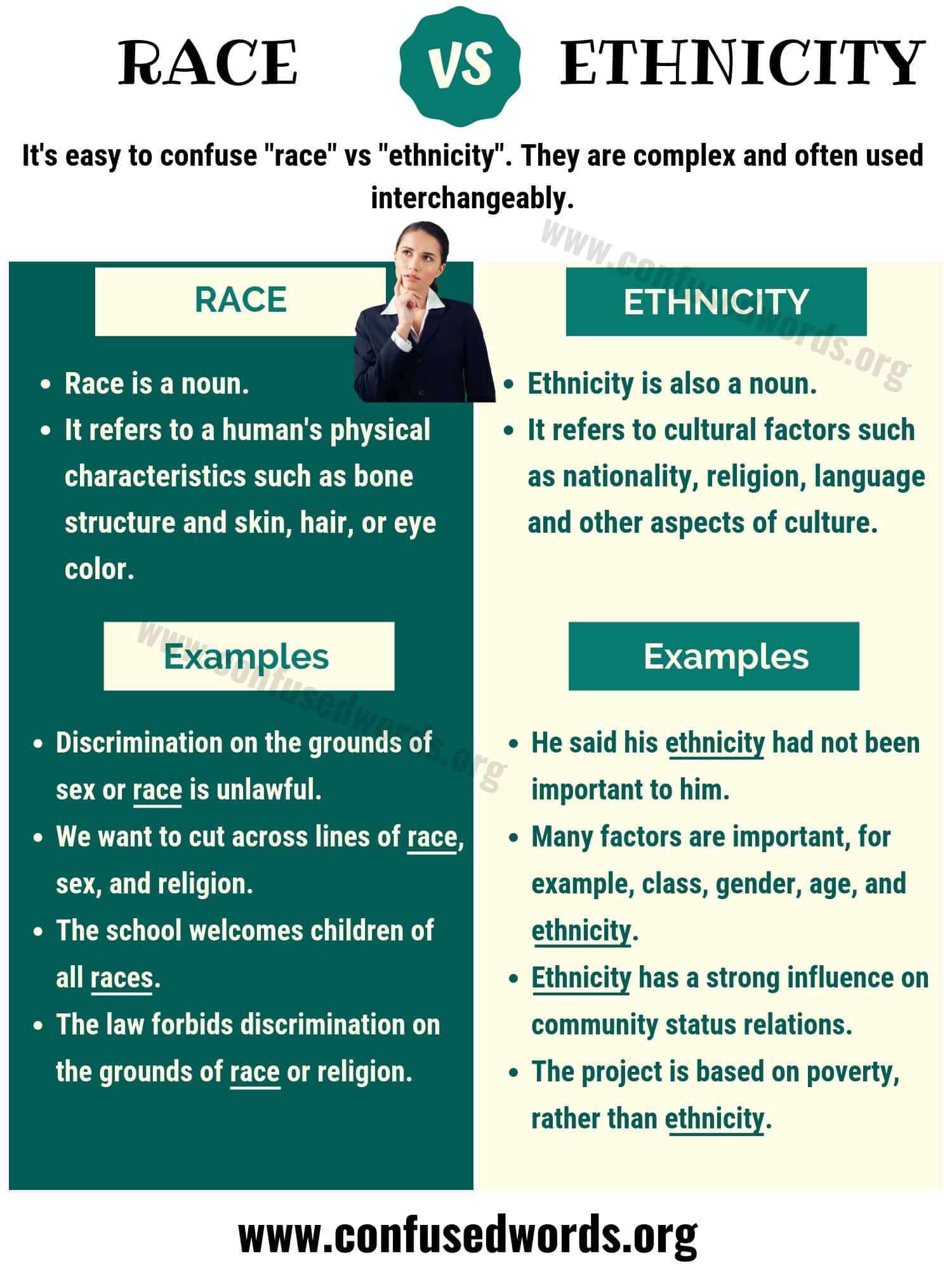Understanding Ethnicity And Race Difference: A Comprehensive Guide
Ethnicity and race difference are two of the most discussed topics in today’s globalized world, yet they are often misunderstood or used interchangeably. While both terms relate to human identity, they hold distinct meanings and implications. Ethnicity refers to shared cultural practices, traditions, and heritage, while race is primarily associated with physical characteristics like skin color. Understanding these differences is crucial in fostering inclusivity and breaking down societal barriers. Whether you’re examining these concepts through a sociological lens or exploring their impact on personal identity, the distinctions between ethnicity and race difference can offer profound insights into human diversity.
In today’s interconnected world, the conversation around ethnicity and race difference has taken center stage in discussions about equality, representation, and cultural understanding. Ethnic groups often share a common language, religion, or history, which binds them together, while race is a broader classification based on physical traits. Despite their differences, both concepts have been historically used to categorize people, often leading to stereotypes and discrimination. By delving into these topics, we can better appreciate the richness of human diversity and work toward dismantling systemic biases.
From a global perspective, ethnicity and race difference play a significant role in shaping social dynamics, political policies, and even economic opportunities. For instance, ethnic minorities often face unique challenges in accessing resources, while racial discrimination continues to plague many societies. By exploring these differences in depth, we can identify areas for improvement and foster a more inclusive future. This article will guide you through the complexities of ethnicity and race difference, shedding light on their historical roots, societal implications, and the ways they intersect with identity.
Read also:Shannon Bream Unveiling The Life And Career Of A Renowned Journalist
Table of Contents
- What Are the Core Differences Between Ethnicity and Race?
- How Do Ethnicity and Race Difference Influence Identity?
- Historical Perspectives on Ethnicity and Race Difference
- Why Is It Important to Understand Ethnicity and Race Difference?
- How Do Ethnicity and Race Difference Impact Society?
- Addressing Misconceptions About Ethnicity and Race Difference
- What Role Do Ethnicity and Race Difference Play in Global Politics?
- Promoting Inclusivity in a World of Ethnicity and Race Difference
What Are the Core Differences Between Ethnicity and Race?
At first glance, ethnicity and race difference may seem similar, but they are fundamentally distinct. Ethnicity is tied to cultural factors such as language, religion, and traditions, while race is based on physical attributes like skin color, facial features, and hair texture. For example, someone might identify as ethnically Jewish due to shared religious practices, while their race could be classified as white or Middle Eastern based on physical traits.
To further clarify these distinctions, let’s break them down:
- Ethnicity: Refers to shared cultural heritage, including language, customs, and ancestry. It is often self-identified and can change over time.
- Race: Refers to a classification system based on physical characteristics. Unlike ethnicity, race is often externally assigned and has been historically used to justify social hierarchies.
These differences are particularly evident when examining ethnic and racial diversity across the globe. For instance, in the United States, African Americans and Black immigrants may share racial similarities but have vastly different ethnic backgrounds. Similarly, in South Asia, people of the same race may belong to diverse ethnic groups, such as Bengalis, Tamils, or Punjabis. Understanding these nuances is essential for appreciating the complexity of human identity.
How Does Ethnicity Shape Cultural Identity?
Ethnicity plays a pivotal role in shaping cultural identity, as it encompasses the traditions, values, and practices passed down through generations. For example, someone of Mexican ethnicity might celebrate Día de los Muertos, while someone of Chinese ethnicity might observe Lunar New Year. These cultural markers help individuals connect with their heritage and build a sense of belonging.
However, ethnicity is not static. People can adopt new cultural practices or identify with multiple ethnic groups, especially in multicultural societies. This fluidity highlights the dynamic nature of ethnicity and its role in personal identity.
Why Is Race Often Misunderstood?
Race is often misunderstood because it has been historically used as a tool for division and oppression. For centuries, racial classifications were used to justify slavery, colonization, and segregation. Even today, racial stereotypes persist, influencing how people are perceived and treated. By examining these misconceptions, we can work toward dismantling harmful biases and promoting equality.
Read also:Dafne Keen Blowjob
How Do Ethnicity and Race Difference Influence Identity?
Identity is a complex tapestry woven from various threads, including ethnicity and race difference. These factors influence how individuals see themselves and how they are perceived by others. For example, someone who identifies as ethnically Korean but racially Asian may experience a dual identity shaped by both cultural and physical traits.
Let’s explore how these influences manifest in everyday life:
- Personal Identity: Ethnicity and race difference contribute to self-perception, shaping values, beliefs, and behaviors.
- Social Identity: These factors affect how individuals are categorized and treated within society, influencing opportunities and challenges.
- Collective Identity: Ethnic and racial groups often form communities based on shared experiences, fostering solidarity and mutual support.
For instance, in the United States, African American communities have historically used cultural practices like music and art to express their collective identity. Similarly, Indigenous groups around the world have preserved their ethnic heritage through storytelling and traditional ceremonies.
How Do Ethnicity and Race Difference Affect Youth?
For young people, ethnicity and race difference can significantly impact their development. Adolescents often grapple with questions of identity as they navigate cultural expectations and societal norms. For example, a biracial teenager might struggle to reconcile their dual heritage, while an immigrant youth might face challenges adapting to a new cultural environment.
Can Ethnicity and Race Difference Coexist Harmoniously?
Yes, ethnicity and race difference can coexist harmoniously when individuals and societies embrace diversity. By fostering mutual respect and understanding, we can create environments where people of all backgrounds feel valued and included.
Historical Perspectives on Ethnicity and Race Difference
The concepts of ethnicity and race difference have evolved over centuries, shaped by historical events and power dynamics. From the transatlantic slave trade to colonialism, these categories have been used to justify exploitation and inequality. Understanding this history is crucial for addressing the lingering effects of systemic racism and ethnic discrimination.
Why Is It Important to Understand Ethnicity and Race Difference?
Understanding ethnicity and race difference is vital for promoting social justice and inclusivity. By recognizing the unique challenges faced by different groups, we can work toward equitable solutions and create a more harmonious world.
How Do Ethnicity and Race Difference Impact Society?
Ethnicity and race difference influence various aspects of society, from education and employment to healthcare and politics. For example, ethnic minorities often face disparities in access to resources, while racial biases can affect hiring practices and law enforcement.
Addressing Misconceptions About Ethnicity and Race Difference
Misconceptions about ethnicity and race difference abound, often perpetuating stereotypes and discrimination. By educating ourselves and others, we can challenge these harmful beliefs and promote understanding.
What Role Do Ethnicity and Race Difference Play in Global Politics?
Ethnicity and race difference are central to global politics, influencing policies on immigration, multiculturalism, and human rights. For example, ethnic tensions have fueled conflicts in regions like the Balkans, while racial discrimination has sparked movements for equality worldwide.
Promoting Inclusivity in a World of Ethnicity and Race Difference
Inclusivity requires acknowledging and celebrating ethnicity and race difference. By fostering dialogue and collaboration, we can build a world where diversity is seen as a strength rather than a divide.
FAQs
What is the difference between ethnicity and race?
Ethnicity refers to cultural factors like language and traditions, while race is based on physical characteristics such as skin color.
How do ethnicity and race difference affect identity?
They shape how individuals see themselves and how they are perceived by society, influencing personal, social, and collective identity.
Why is understanding ethnicity and race difference important?
It promotes social justice, inclusivity, and mutual respect, helping to address systemic biases and create a more equitable world.
For further reading, explore this resource on race and ethnicity.
Conclusion
Ethnicity and race difference are complex yet essential aspects of human identity. By understanding their distinctions and impacts, we can foster a more inclusive and equitable society. Let’s embrace diversity and work together to build a brighter future for all.
What Is The Full Meaning Of DGAF? Exploring Its Origins, Usage, And Cultural Impact
Discover The Best Beeswax For Sale In The USA: Why Lappes Bee Supply Stands Out
What Was Dorothy Vaughan's Education? Exploring The Life Of A Trailblazing Mathematician

Difference Between Race And Ethnicity NBKomputer

Race vs ethnicity what is the difference between them? Live Science